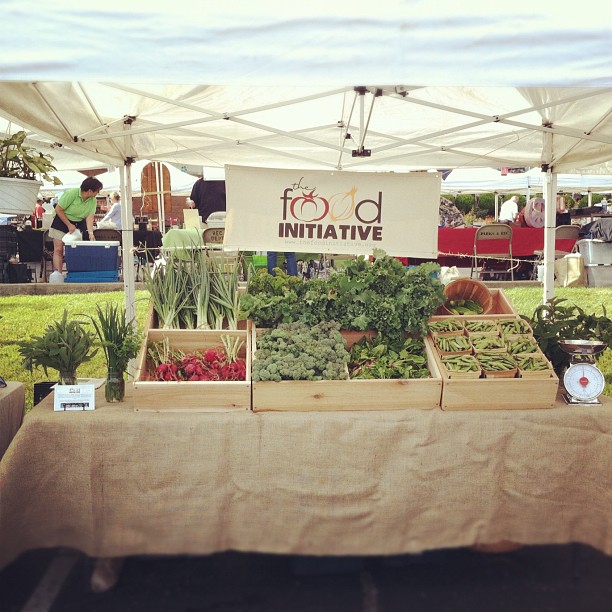 The following is an email interview I had with Michael Hampton from The Food Iniative, a project working with youth to help strengthen the local food economy in Clarksville, TN. I asked him a few questions about The Food Initiative, how it started and the impact it is having on the Clarksville community and got some really great answers!
The following is an email interview I had with Michael Hampton from The Food Iniative, a project working with youth to help strengthen the local food economy in Clarksville, TN. I asked him a few questions about The Food Initiative, how it started and the impact it is having on the Clarksville community and got some really great answers!
Q: What do you think of when I say the phrase “Food Justice”?
A: I immediately think of local farms and local markets. A network of local growers and consumers who are passionate about the quality of food and the quality of the land that it comes from is the key to creating Food Justice. It takes community cooperation to achieve Food Justice.
Q: What kind of food access issues do you have in your community?
A: There are several areas in our community that have very little access to markets with fresh foods. The food sources in these neighborhoods are quick stop convenience stores. These stores contain mostly processed foods with the fresh foods being the occasional apple and banana. The prices are also higher than supermarkets and grocery stores. Clarksville is a community that is large and spread out. The neighborhoods that have fewer markets also tend to be less affluent niehgborhoods. These citizens are faced with a decision to either buy processed foods at a high price, or spend time and money on transportation to reach a farmer’s market or supermarket.
Q: How did you come up with the idea to start The Food Initiative?
A: The Food Initiative was started by a Patrick and Catherine Smith. They saw the need for a program to get youth involved in their community and working and learning together. Several different programs were created and piloted. The Food Initiative is a program that saw dramatic results in the lives of youth while serving the community at the same time.
Q: What kind of local resource people did you recruit for advice in getting the project off the ground?
A: The Food Initiative has partnered with many different organizations and individuals in Clarksville and other communities. The Boston Food Project provided materials and training for some of the staff of The Food Initiative. A former employee of The Boston Food Project also helped with structure and training for The Food Initiative staff on location in Clarksville. We currently partner with three local hunger relief organizations to better understand the food needs of our community and how we can best serve the community with our youth and produce. Austin Peay State University also provides experience, training, and garden space. The head of the agricultural department, Dr. Sudbrink, works alongside our staff and youth in garden work providing knowledge and advice. We have also partnered with local doctors, medical professionals, nutritionists, and chefs to design our health curriculum.
Q: How has The Food Iniative improved the health and wellness of your community members?
A: Each youth participates in various, interactive health workshops in which they learn about the ingredients in their food and how our bodies process those ingredients. We set health goals and discuss how small steps now can have permanent long term affects on our health. We also provide opportunities for our youth and our community to enjoy the harvest from our garden. We make our organically grown produce available through donations to hunger relief organizations, selling at our downtown market, and setting up stands in lower income neighborhoods. We are creating awareness and health ambassadors by providing opportunities for learning.
Q: How do you perceive this project to address some of the root causes of hunger?
A: We are attempting to fight hunger through food access. We are attempting to make food more available and more affordable through our vegetable stands. We are also providing youth with the knowledge and confidence to grown their own food. Our youth also have the opportunity to work in three different hunger relief organizations. This connects youth with volunteer opportunities that they can help fight hunger right here in Clarksville. Finally we address hunger through economic workshops. Our youth receive a stipend each week and learn the basics of budgeting, planning, and prioritizing with their money. Some of our youth come from these families who are being served at the hunger relief organizations. They are learning that a hunger relief organization is not only a place they can go to for resources, but a place that they can go to serve.

Q: Where do you see the Food Initiative in 10 years?
A: Right now TFI works with about 40 youth per year on a borrowed site of about 2 acres. In 10 years, I see TFI working with around 100 youth each year, a permanent site of about 10 acres full of produce and even some poultry, school gardens, and multiple small urban garden sites that our youth help coordinate and connect with the community.

There are several internet-based ways for you to keep up with the current happenings at The Food Initiative too:
https://www.facebook.com/thefoodinitiative
And my personal favorite, Instagram:@thefoodinitiative
For helpful ideas on how to get your own Food Justice project off the ground please email or call our National Food Security Coordinator: arianna.king@pcusa.org or (502) 569-5818. Happy Growing!